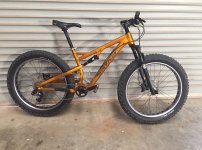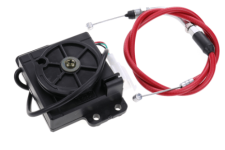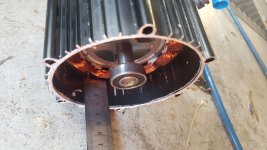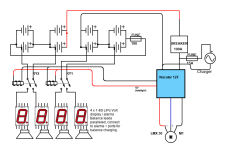This thread is a spin off from Observed trials bike designing. That thread is around making the design decisions, this one will hopefully chronicle the build.
This bike will be a modified full suspension fat bike, aimed at being a dedicated trials bike. Speed is definitely not a factor, torque, responsiveness and manoeuvrability are.
I currently firmly believe a mechanical clutch is an advantage on a trials bike for a whole lot of reasons, so I'm trying to fit one into this build. If it just gets too hard I'll abandon the clutch and fit an "electronic clutch" - basically a reverse throttle on the clutch lever - definitely not my preferred option though.
Some of my goals are:
* Reasonable reliability - I only want to have to do regular maintenance tasks, not constant rebuilding. I don't want to be overloading the frame so much I'm in constant fear of it breaking. I'll accept a certain amount of breakage of running gear while I dial it in though.
* 45 minutes to 1.5 hour ride time in trials sections. To start I'm aiming at the low end to keep weight, bulk and price down.
* Build cost ideally not over AU$3,500.
* Good safety on the battery - I want a reliable BMS, a well protected battery case and durable internal connections. I ride in areas that have high fire risk.
I'll try to keep the second post in this thread as a record of the components, so it's easier to find the final outcomes as they inevitably change during the process.
This bike will be a modified full suspension fat bike, aimed at being a dedicated trials bike. Speed is definitely not a factor, torque, responsiveness and manoeuvrability are.
I currently firmly believe a mechanical clutch is an advantage on a trials bike for a whole lot of reasons, so I'm trying to fit one into this build. If it just gets too hard I'll abandon the clutch and fit an "electronic clutch" - basically a reverse throttle on the clutch lever - definitely not my preferred option though.
Some of my goals are:
* Reasonable reliability - I only want to have to do regular maintenance tasks, not constant rebuilding. I don't want to be overloading the frame so much I'm in constant fear of it breaking. I'll accept a certain amount of breakage of running gear while I dial it in though.
* 45 minutes to 1.5 hour ride time in trials sections. To start I'm aiming at the low end to keep weight, bulk and price down.
* Build cost ideally not over AU$3,500.
* Good safety on the battery - I want a reliable BMS, a well protected battery case and durable internal connections. I ride in areas that have high fire risk.
I'll try to keep the second post in this thread as a record of the components, so it's easier to find the final outcomes as they inevitably change during the process.









